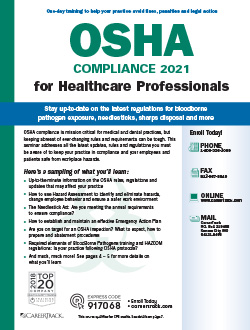Ensure Safety. Avoid Penalties. Stay Compliant.
In the fast-paced world of healthcare, staying current on the latest OSHA regulations isn’t just important — it’s essential. This comprehensive OSHA compliance training course is designed specifically for healthcare professionals working in medical and dental practices, equipping them with the tools and knowledge needed to create a safer work environment and meet critical compliance standards.
Why OSHA Training Matters
Whether you're managing bloodborne pathogen exposure, needlestick safety, sharps disposal, or emergency preparedness, OSHA training for healthcare professionals ensures you stay ahead of evolving safety standards. Non-compliance can lead to hefty fines — up to $7,000 per serious violation, and up to $70,000 for repeat offenses. Don’t let your practice fall behind.
One Day. Full Compliance.
We understand your time is valuable. That’s why this streamlined, one-day OSHA training experience is designed for maximum impact. You’ll leave with actionable insights and a deeper understanding of OSHA’s general and healthcare-specific standards — all in a single day.
Whether you run a bustling dental clinic or a growing medical practice, this dental OSHA training ensures your team knows what to do, how to do it, and how to document it properly.
Who Should Attend?
This course is ideal for anyone responsible for OSHA compliance in a healthcare setting, including:
- Nurses and Nurse Practitioners
- Hygienists and Dental Assistants
- Office and Practice Managers
- Physicians, Dentists and Physician Assistants
- Medical Assistants, Lab Personnel, Technicians
- Safety Officers and Risk Managers
Be Ready for OSHA Inspections
OSHA inspections are on the rise — and your practice needs to be prepared. Learn how to navigate onsite visits, respond to complaints, and handle abatement procedures efficiently. We’ll break down OSHA’s most common healthcare citations and show you how to address them before they become an issue.
Your Free OSHA Compliance Workbook
All attendees receive a comprehensive workbook packed with practical tools, checklists, and examples to support ongoing compliance efforts. It’s your go-to resource long after the course ends.
100% Satisfaction Guaranteed
We stand behind our training. If you're not satisfied for any reason, simply contact us within 30 days of your seminar, and we’ll make it right — attend another session or get a full refund.
Stay safe. Stay compliant.
Join thousands of professionals who rely on Pryor Learning for OSHA compliance training that delivers real-world results.
Enroll today and ensure your medical or dental practice is OSHA inspection-ready.
